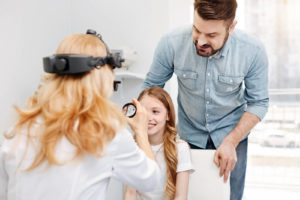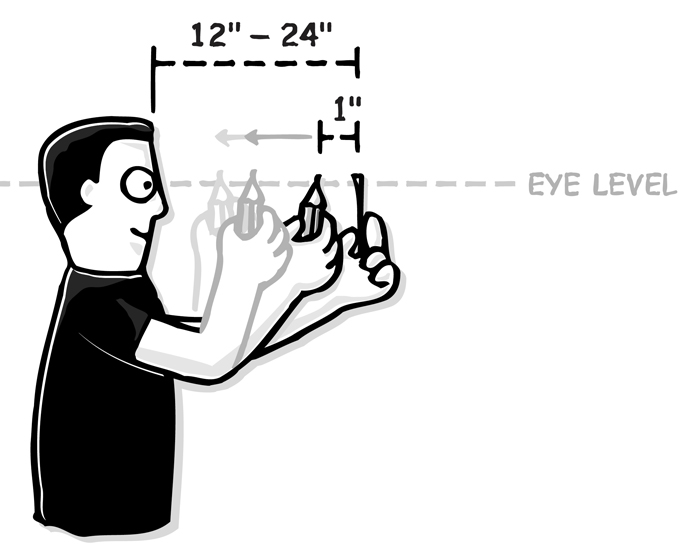
12 Common Eye Problems in Children That Parents Might Miss
One thing that the vast majority of parents have in common is that they want their children to thrive. Keeping up with the recommended appointment schedule for the pediatrician and the dentist is often a no-brainer. However, many parents unfortunately stop there. After all, who wants to add another appointment to the schedule, especially when it can be so difficult to get your child in the car when they know there might be some discomfort involved? Unfortunately, this often means that kids’ eye appointments remain unscheduled, and even more unfortunately, it means that many common eye problems in children go undetected.

When considering common pediatric eye conditions, most parents are familiar with pink eye, styes, or irritation caused by allergies. If these pop up, most adults know they need to wrangle their little ones and bring them to either the eye doctor or a pediatrician. But there are other eye conditions in children out there that can lead to serious consequences if left untreated.
Kids are prone to eye problems (such as pink eye or styes) because the spread of infection is more common when they’re young. Luckily, there is a lot we can do to mitigate those risks – that’s why it’s crucial to teach them not to rub their eyes without washing their hands first. And, it’s our job as parents to assess their eyes regularly and take them to the eye doctor when we notice something abnormal. Here are 12 of the most common eye issues that parents should watch out for.
1. Dry Eyes
Children born in the 2010s and 2020s are exposed to more technology than kids of any generation before them. While there are lots of benefits to this, from increased access to information to an easy way to get a much-needed break for parents, increases in screen time also have a lot of drawbacks for kids. One of the most common eye problems in children caused by high levels of screen time is dry eye. In fact, in a recent study, scientists found that a cumulative device exposure time of more than 3-3.5 hours per day significantly increased a child’s risk of developing pediatric dry eye syndrome. This is because we tend to blink less when we’re watching something on a screen, lubricating our eyes less than we should. As we all know, dry eyes can cause redness, irritation, and itchiness, which is even less fun to deal with when you’re really little.
2. Conjunctivitis
Also known as pink eye, conjunctivitis is a viral infection that is one of the most well-known eye problems in children. It happens when kids touch their eyes with dirty hands. It can also be caused by sleeping on an infected pillow or using an infected towel. It’s crucial that kids don’t share these items at school or home. Most commonly, kids who don’t wash their hands well after using the bathroom can infect themselves by rubbing their eyes. Although it goes away with medication, it’s best to avoid the spread of conjunctivitis by teaching proper hygiene skills.
3. Eyelid Styes
Styes are tiny pockets of bacteria in the hair follicles and pores of the eyelid. If your kiddo is complaining of pain in their eye, you should look to see if there is a small, swollen bump between your child’s eyelashes. It can feel hard and tender, causing some noticeable discomfort. Like pink eye, styes are spread by poor hygiene skills. Luckily, you can treat them with medication, or some will go away with regular use of a warm compress. To make one, take a washcloth and run it under some warm (but not too hot!) water and apply it to your child’s eye while they are having some downtime. If the sty doesn’t go away after a few days of using a warm compress twice a day, it might be time to take them to the doctor for some medication.
4. Irritation from Allergies
It’s common for school-aged children to develop seasonal allergies. According to the CDC, nearly one in five children suffers from this condition. They could be allergic to pollen in the air, the growth of mold in their school building, or even insect bites. Allergies impact children by causing irritation and redness in the eyes, watery eyes, and frequent eye rubbing. Even if you can see allergy symptoms in your child, without allergy testing, it’s hard to know exactly what they are allergic to. Regardless of what’s causing it, you may need to see a doctor and get allergy eye drops to use in the spring and summer.
5. Hand-Eye Coordination Issues
School-aged children are in the midst of developing their hand-eye coordination. They need this skill for playing sports, reaching for objects, and even bringing food from their plate to their mouth. It’s important for children to have regular eye doctor checkups to ensure their coordination develops. Sometimes, it can be affected by poor eye teaming, poor eye tracking, and poor spatial awareness. If one of these is the case, your doctor may recommend physical therapy and exercises to train the eye muscles.
6. Myopia
You will likely start to notice most signs of vision problems in kids when they start school. One of the most common issues that shows up during that period is myopia, or nearsightedness. If your child suffers from nearsightedness, it means that they likely have difficulty reading the board in class or objects farther than a few yards away. Children with myopia need to sit at the front of the classroom until they get glasses to correct their vision. Luckily, a myopia diagnosis isn’t a permanent sentence for bad vision at a young age. Our vision can change as we age, so it’s important to do eye exercises with your children and take them for regular eye exams. The more you do to help them strengthen their vision now, the better their vision will be later in life.
7. Hyperopia
Hyperopia, or farsightedness, is another one of the many common eye problems in children. In fact, nearly one in seven kids experiences some level of hyperopia. Luckily, many kids will grow out of this as their eyes develop. However, it’s still important to take kids in for eye exams so that this issue can be detected and treated (usually with corrective lenses), so that kids have the best chance of maintaining good vision when they are older.
8. Amblyopia
Amblyopia is another way of saying “lazy eye.” It occurs when one eye’s muscles are stronger and receive more signals from the brain than the other. This results in one eye being focused and easy to control, and the other being misaligned. This is a problem that requires physical therapy at home and the guidance of an ophthalmologist. It needs to be addressed immediately because, often, without treatment, this condition will get worse. But, never fear – if properly addressed, your child’s misaligned eyes will likely completely heal.
9. Convergence Insufficiency
This problem is caused by your child’s eyes’ inability to look inwards and work together, such as when they are reading a book. It can cause headaches and double vision. If your child complains of these symptoms, they need to see an eye doctor. You should ask your provider for both a comprehensive exam as well as the standard exam, since the latter doesn’t always detect convergence insufficiency. Once diagnosed, the treatment can vary from reading glasses to eye exercises that work on close-up vision.
10. Strabismus
Strabismus is just another fancy word for crossed eyes. This is another eye condition that can be easily treated when kids are young, but it gets more difficult as they get older. If you notice your child developing crossed eyes as they get older, get them into the eye doctor as soon as you can. The doctor will likely start with an eye patch. Patching the dominant eye of an amblyopic child forces them to use their less dominant eye, hopefully restoring more balanced sight. Applying atropine to the less-developed eye has also worked well. Treatment isn’t so easy in older children and adults. Still, the picture isn’t entirely bleak. Several vision therapies have been shown to provide at least temporary improvement, and researchers are still looking into ways to tackle the issue.
11. Ptosis
Congenital ptosis occurs when the child’s eye muscles aren’t strong enough to hold up the eyelid. This causes drooping in one or both eyelids. If your child is suffering from this condition, you may notice them tilting or leaning their head back to see. This isn’t a pediatric eye condition to mess around with – ptosis can be caused by serious eye issues like tissue diseases or tumors. Even if it isn’t caused by one of these problems, it’s important to have a doctor assess your kids’ condition so it can be treated. Left untreated, ptosis can lead to a lazy eye, crossed eyes, or astigmatism.
12. Blocked Tear Duct
The tear duct is the eye’s drainage system. It cleans tears and debris from the eyes. When one or both tear ducts have a blockage, the eye can become irritated and infected. It’s somewhat common for newborn babies to have blocked tear ducts. Although it can go away with time, there are special massage techniques you can do to help clear the blockage. Untreated, the blockage causes a constantly runny and infected eye. Your child can experience irritation, swelling, and a constant flow of tears.
Tackling the Most Common Eye Problems in Children
We don’t mean to scare you; we just want you to be aware of some of the most common eye problems in children so you’ll know what to do if your child starts displaying symptoms. While you can treat some of them at home with natural remedies, others may need your doctor’s guidance. Get in the habit of regularly checking your children’s eyes for infection and other abnormalities. Notice how and if they strain their eyes to see.
In many cases, your child will complain of irritation or soreness in the eye. If they can’t yet speak, notice if they’re rubbing their eyes more than normal. Being aware of their vision problems allows you to treat or solve them faster. Most of these common eye problems are completely treatable.
Our Rebuild Your Vision Ocu-Plus Formula Contains All 17 Vitamins, Minerals, and Herbal Supplements to Improve Your Eye Health!




Leave Your Reply